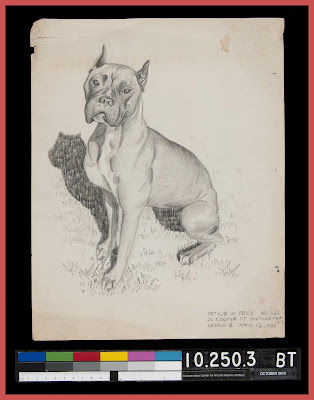 |
| Art on tissue paper by June Anderson. |
The art on this tissue paper is particularly fragile and precious. During their courtship, my father had bugged my mother to show him some of the fashion illustration work she was learning at Traphagen School of Fashion. She finally responded by sketching a variety of typical fashion poses on a large sheet of tracing paper. All around the pictures, she jotted her notes with a felt pen. Then she folded the piece up tightly and mailed it off to Southampton with a letter.
 |
| Closeup of Jessica Keister's treatment. |
When I brought the piece into the Conservation Center
Jessica Keister, Mellon Fellow at the Conservation Center
Norman “Sailor Jerry” Collins is regarded as one of the great tattoo artists of the past century. Working from the mid-1940s through the 1960s, Sailor Jerry often used tissue paper to sketch his fanciful stencil designs. Tissue paper is a little unusual in paper conservation because it doesn’t take well to washing and its transparent nature
makes it easy to see normal mends. Therefore, the
 |
| Conservator Samantha Sheesley treating Sailor Jerry stencils. |
conservators adopted new techniques, including the use of an ultra-thin machine-made Japanese paper and an acrylic adhesive. The result worked well for both Sailor Jerry’s, and my mother’s, artwork. The mends are barely visible under normal lighting conditions.
I’m delighted with the result – just as the people at Sailor Jerry Limited are pleased with their treatments. My mother’s treated artwork will go into storage. The Sailor Jerry work goes on tour, with exhibition stops scheduled at Mystic Seaport (Mystic, CT) and the Columbia River Maritime Museum (Astoria , OR
 |
| Art on tissue paper by June Anderson, before treatment. |
 |
| Art on tissue paper by June Anderson, after treatment. |
© 2011 Lee Price















































